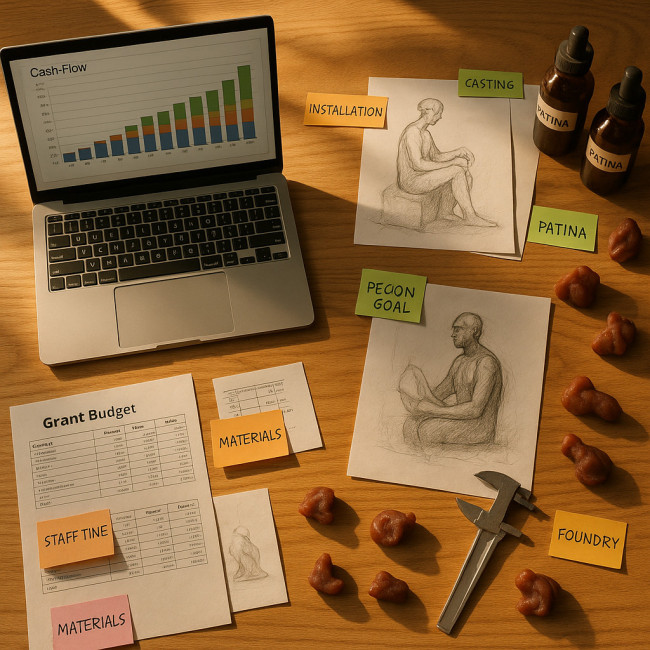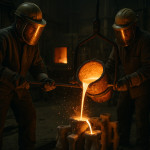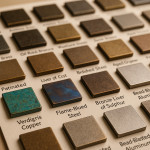Grant budgets for sculptors: template to align milestones with funder goals
Creating a convincing grant budget can mean the difference between “funded” and “rejected.” This guide offers a ready-to-adapt template that links each project milestone to funder goals, so sculptors can present numbers that resonate with decision-makers.
Why sculptors need a milestone-driven budget

Most grant panels evaluate two things: the artistic vision and the feasibility of the work. A milestone-driven budget for sculptors connects those dots in one glance. It shows when money is needed, what outcomes it buys, and how each spend backs the funder's mission—whether that is community impact, material innovation or public access.
Benefits at a glance
- Clarity for funders: easy to match line items with deliverables.
- Planning for sculptors: reveals cash-flow gaps before they hit.
- Credibility boost: proves you understand real-world logistics like shipping safeguards and installation permits.
Core sections of a grant budget template
| Section | Typical Range (%) | Funder Angle |
|---|---|---|
| Materials & fabrication | 35–45 | Innovation, sustainability, local sourcing |
| Artist & assistant fees | 20–30 | Fair pay, skill development |
| Studio & equipment | 8–12 | Infrastructure, safety |
| Professional services (engineers, installers) | 8–12 | Risk mitigation, longevity |
| Documentation & outreach | 5–8 | Public impact, education |
| Contingency | 5–7 | Realism, project resilience |
Step-by-step: Building your budget
1. Map creative milestones
List the big moments—concept approval, scale mock-up, casting, finishing, installation, community unveiling. For each, add a date and a measurable output (e.g., “Bronze cast delivered: 350 kg, ready for patina”).
2. Assign cost lines to each milestone
Break expenses into direct and indirect. Example:
- Direct: raw bronze, mould rubber, eco-friendly solvents, foundry fees.
- Indirect: studio rent for mould-making month, liability insurance, project management.
If you specialise in low-carbon alloys, reference your sourcing strategy—funders committed to the environment love concrete proof. For deeper tips, browse eco-minded material sourcing.
3. Tie each cost to a funder goal
Study the grant guidelines. Do they emphasise public engagement? Then show how your documentation & outreach line funds an augmented-reality walkthrough hosted on the craft-designer directory most of their audience visits.
4. Add justification notes
Panelists skim hundreds of proposals. A brief note like “Studio ventilation upgrade—complies with OSHA silica standards” can avoid follow-up queries.
5. Check cash flow
Grants often release funds in tranches. Make sure fabrication deposits line up with disbursement dates. When cash gaps appear, explain bridge solutions: part-payment from a commissioning partner or phased material orders.
Visual guide: average sculptural project budget
Source : National Endowment for the Arts
Download-ready budget template
Copy this structure into your favourite spreadsheet or grant portal.
- Header: Project title, grant ID, applicant info.
- Milestone section: Date | Output | Fund release | KPI.
- Line-item table: Category | Cost | % of total | Milestone link | Funder goal.
- Narrative notes: 2-line justification beneath each major cost.
- Totals & contingency: calculate both euro and percentage values.
Common red flags and quick fixes
- Overly round numbers: Replace “€10 000 materials” with “€9 845 bronze ingots (350 kg @ €28.13/kg).”
- No artist fee: Panels often reject budgets that don't value labour. Use regional rate guides or the portfolio audit method to benchmark.
- Missing documentation costs: Funders need impact metrics. Add photography, videography or even drone flyovers for large works.
- Zero contingency: Set 5-7 %. If you never need it, you can ask to re-allocate later—funders prefer that to mid-project emergencies.
Alignment tactics for specific funder types
Public art councils
Highlight community workshops, site accessibility and long-term maintenance. Link outreach spend to foot-traffic projections, and reference precedents like grant proposals that funded glass innovators for credibility.
Private foundations
They love innovation. Showcase experimental materials or new casting techniques. Break R&D costs out clearly, and cite partnerships with universities or foundries.
Corporate sponsors
Focus on brand visibility and ESG metrics. Document recycled material percentages, low-carbon shipping methods and employee engagement events. For guidance, see impact metrics for land art.
FAQ
- How detailed should sculptor budgets be?
- Panels prefer precise, justified figures. Aim for line items down to individual processes (e.g., TIG welding gas refills) when they exceed 1 % of total cost.
- Can I include in-kind contributions?
- Yes. Show them in a separate column with fair market value. Funders view strong in-kind support as proof of community buy-in.
- What if material prices fluctuate?
- Add a footnote citing the commodity index used and set contingency at 7 %. Panels understand metal markets.
- Is sales tax eligible?
- Usually, no. Most grants cover net costs. Confirm in guidelines and list tax separately if required.
- How early should outreach costs appear?
- From day one. Funders want to know how you will promote and document the work throughout the process, not just at the unveiling.
Quick self-assessment quiz
Next steps
Download the template, insert your milestone dates and adjust percentages to match your technique and scale. Before submitting, cross-check cash flow against disbursement schedules and ensure every euro links back to a funder priority.
Ready to impress panelists? Use the template today and secure the resources you need for your next masterpiece.











